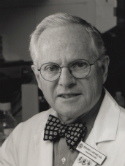Histone deacetylase inhibitors induce remission in transgenic models of therapy-resistant acute promyelocytic leukemia Journal Article
| Authors: | He, L. Z.; Tolentino, T.; Grayson, P.; Zhong, S.; Warrell, R. P. Jr; Rifkind, R. A.; Marks, P. A.; Richon, V. M.; Pandolfi, P. P. |
| Article Title: | Histone deacetylase inhibitors induce remission in transgenic models of therapy-resistant acute promyelocytic leukemia |
| Abstract: | Acute promyelocytic leukemia (APL) is associated with chromosomal translocations, invariably involving the retinoic acid receptor α (RARα) gene fused to one of several distinct loci, including the PML or PLZF genes, involved in t(15;17) or t(11:17), respectively. Patients with t(15;17) APL respond well to retinoic acid (RA) and other treatments, whereas those with t(11;17) APL do not. The PML-RARα and PLZF-RARα fusion oncoproteins function as aberrant transcriptional repressors, in part by recruiting nuclear receptor-transcriptional corepressors and histone deacetylases (HDACs). Transgenic mice harboring the RARα fusion genes develop forms of leukemia that faithfully recapitulate both the clinical features and the response to RA observed in humans with the corresponding translocations. Here, we investigated the effects of HDAC inhibitors (HDACIs) in vitro and in these animal models. In cells from PLZF-RARα/RARα-PLZF transgenic mice and cells harboring t(15;17), HDACIs induced apoptosis and dramatic growth inhibition, effects that could be potentiated by RA. HDACIs also increased RA-induced differentiation. HDACIs, but not RA, induced accumulation of acetylated histones. Using microarray analysis, we identified genes induced by RA, HDACIs, or both together. In combination with RA, all HDACIs tested overcame the transcriptional repression exerted by the RARα fusion oncoproteins. In vivo, HDACIs induced accumulation of acetylated histones in target organs. Strikingly, this combination of agents induced leukemia remission and prolonged survival, without apparent toxic side effects. |
| Keywords: | cancer survival; controlled study; unclassified drug; oncoprotein; human cell; histone deacetylase inhibitor; cancer growth; drug efficacy; nonhuman; antineoplastic agents; animal cell; mouse; animals; mice; cell cycle; cell division; apoptosis; animal experiment; animal model; protein binding; gene locus; gene product; cell differentiation; transcription, genetic; drug effect; tumor cells, cultured; time factors; transgenic mouse; mice, transgenic; leukemia, promyelocytic, acute; blotting, western; transcription regulation; enzyme inhibitors; oligonucleotide array sequence analysis; histone; nucleotide sequence; acute myeloblastic leukemia; fusion gene; hydroxamic acids; remission induction; microscopy, fluorescence; up-regulation; blotting, northern; drug sensitivity; histone deacetylases; retinoic acid; models, chemical; arylbutyric acid derivative; dna, complementary; leukemia remission; growth inhibition; retinoic acid receptor alpha; retinoic acid receptor; protein plzf; in situ nick-end labeling; hydroxamic acid derivative; receptors, retinoic acid; chromosome translocation 11; target organ; trans-activation (genetics); phenylbutyrates; chromosome translocation 17; humans; human; priority journal; article |
| Journal Title: | Journal of Clinical Investigation |
| Volume: | 108 |
| Issue: | 9 |
| ISSN: | 0021-9738 |
| Publisher: | American Society for Clinical Investigation |
| Date Published: | 2001-11-01 |
| Start Page: | 1321 |
| End Page: | 1330 |
| Language: | English |
| DOI: | 10.1172/jci200111537 |
| PUBMED: | 11696577 |
| PROVIDER: | scopus |
| PMCID: | PMC209432 |
| DOI/URL: | |
| Notes: | Export Date: 21 May 2015 -- Source: Scopus |
Altmetric
Citation Impact
BMJ Impact Analytics
MSK Authors
Related MSK Work






